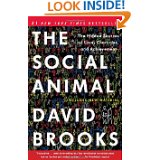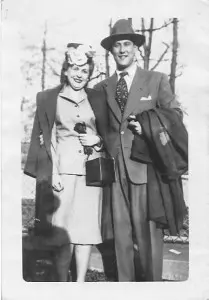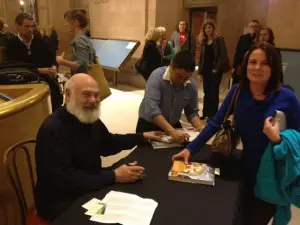Kensington in the Spotlight
February 22, 2015
Recently, I’ve had a few calls from friends around the country asking bluntly, “What the heck is going on in Kensington?”
For those of you who missed it, our little town has been the subject of some notoriety since it was revealed that an off-duty police officer ( and three other colleagues) drove to Reno, NV (about 3 hours) for a weekend of fun and promptly lost his gun, badge, handcuffs, and ammunition to a prostitute.
Journalistically, the best part of the story was how the gun was recovered the next day, when the woman’s pimp apparently shot himself during a dispute when he was attempting to pawn the items.
Our local police chief “investigated” the matter for 8 months but only suspended the officer when the story became public. As you might expect, the community was a bit upset at the chief’s delay. Over 250 folks turned out for a police board meeting on the issue.
He’s now our former chief, although the suspended officer is still on the force.
Kensington is a small upper-middle class community in the East Bay hills. Our major claim to fame, until now, was that Daniel Ellsberg lived here. Over 70% of the population have, not only college degrees, but advanced degrees. The community is off the beaten track, and most of us like it that way. There are no major roads that would lead anyone to come here, unless you were on the way to your home, and most of the time when you tell someone you live in Kensington the reaction is “where’s that?”
Plus, we pay a yearly assessment, so that we can have a police department of 10, dedicated to patrolling our streets to protect us from the rest of the world. We also have an excellent elementary school which makes this a great place to raise a family.
The spotlight that has been shining on us over the last few weeks, has been very uncomfortable.
I have no new information to reveal about what will happen next and most of you probably don’t want to know about the politics of a small, wealthy community in the Bay Area, but there are some things to note.
First, the chief and the 5-member police board to which he reports, have screwed up big time. The chief, who also acts as general manager, will no longer be serving us, and for the second time in ten years, we are looking for a new commander.
Second, a large part of the problem is based in the combination role the police chief is asked to fill. Police Chief and General Manager is just an untenable combination, which the board is finally looking into changing.
Third, a small group of dissidents is using the incident to further their own, long-standing goal of ousting the three majority board members. Additionally, they want us to combine our police force with the neighboring town of El Cerrito, which may make sense financially, but not from a public safety perspective.
This story will continue to play out over the next year. Hopefully out of the national or state-wide spotlight. My hunch is we’ll have a recall election, which will fail, and we will separate the two top posts in town, and then there will be a ballot initiative to combine our police force with our neighbor, which will also fail.
The whole battle will be quite acrimonious, and make for lots of local hand wringing, but in the end, everyone will go back to ignoring the our little town and we can all get on with our lives.
Unconscious Bias
September 24, 2014
A lot has been written over the last year about steps Silicon Valley companies are taking to combat bias in hiring.
In case you missed it, over 70% of the workforce at many firms, is white and male. A recent NYT article details the problem and some proposed solutions.
But I think the issue is closer to most people’s homes than they realize. A recent example helps prove my point.
My ophthalmologist, is the mother of twins , a boy and a girl. I have been seeing her for almost 15 years so I’ve followed the normal trials and tribulations of parenting.
The children are now, at 15, starting to make choices about college and careers. At my last appointment the doctor said the young man had really applied himself and was looking forward to technology/science as a career and was looking at top tech schools.
When I asked about her daughter, the doctor said she found math and science “too hard,” adding,”all my friends just want to get Liberal Arts degrees.” The doctor’s response,”Well, OK, if that’s what you want.”
I was slightly appalled, and my expression must have revealed my thoughts, because she asked, “Do you think I should have pushed her more?”
We had a lengthy discussion, in between eye chart readings. But it made me wonder how many other subtle signals the little girl had received about avoiding math and science.
It’s no surprise the Silicon Valley workforce is overwhelmingly male, if even a professional women, in a field that certainly required some science (ophthalmology), wouldn’t even urge her daughter to consider science and math because they are “too hard.”
Maybe a short visit with an unbiased career counselor/coach would help break through the peer pressure and produce a few more female engineers for the next great startup.
New York Commentary
September 24, 2013
I just got back from New York City , and couldn’t help making some observations:
As California contemplates naming its newest bridge after the still very alive Willie Brown, it’s worth noting that two well known bridges in New York have been unsuccessfully named after two well respected deceased politicians.
The Triborough Bridge was renamed in 2008 after Robert Kennedy and the Queensboro, or 59th Street Bridge, was renamed for former Mayor Ed Koch. Maybe it takes more than a few years, but both names are used only derisively by New Yorkers, despite numerous signs. The cabbies are particularly dismissive, noting they expect soon-to-be former Mayor Michael Bloomberg, to pay to have the Brooklyn Bridge named after himself.
Speaking of Brooklyn. You can’t help but notice how the borough has become the center of the universe to many. With Nets shirts and paraphernalia far out outnumbering Knicks jerseys, even in Manhattan. Brooklyn is the trendy place to live, work, start a new business or just hang out. But more than one New Yorker pointed out how difficult it is to drive anywhere in Brooklyn and a few noted that it still has a lot of rough edges with graffiti decorating many buildings, and toni new restaurants in neighborhoods where you really would not want to walk at night. Maybe they’re just jealous…who knows?
We took a walk along the High Line – the west side railway converted to a pedestrian walkway. The best part of the walk is the section that crosses 10th Avenue, which includes stadium seating behind a row of huge windows. It’s like watching a series of big-screen televisions, all playing reality TV, New York style. A favorite place for natives to enjoy lunch.
You can’t help but notice the increase in bikes in New York City. The Citi Bikes program which allows anyone who signs up, to take a bike from one stand and return it to another, seems to be a hit with New Yorkers. We did witness a number of near-injury accidents with pedestrians and cars. It just adds to the element of surprise in navigating the New York streets. Drivers seem to universally hate the new vehicles, I guess until they get out of their car and on to a bike. A similar program is just getting under way in San Francisco.
We had a very nice chat with a cab driver from Senegal, explaining to him the difference between being a cabbie in NYC and SF. A few hills but fewer cabs: pedestrians who walk first and expect you to stop: drivers who are relatively polite: fewer people; smaller city; and a host of other factors. He added that driving inn New York can be stressful but it’s just part of the job.
Cabbies here are like waitresses in LA. They are all on their way to something else. Our driver from Senegal was just waiting to start his own business (undetermined) and a second cabbie was going to community college to get an AA so he could become a police officer, like his sister. They actually give policemen a small replica badge (3 each) to give to family members that says “brother of policeman” or whatever is appropriate. He says it helps with minor infractions, but does nothing if you’re caught speeding. My brother-in-law is a SF cop, we got nada. (Will have to check on it)
Genetically Modified food doesn’t seem to be a big issue in New York. Maybe it’s just because we had an initiative that failed in California, or maybe it’s just my wife who won’t eat GMO food, but no one seems to even notice GMO’s. Even a restaurant specializing in healthy , nutrient rich food, made no mention of GMO’s on the menu, and our waiter, seemed puzzled when we asked.
Finally, no trip would be complete without some comments on flying. Yes, we continue to use United Airlines, hoping against hope that we’ll score a free upgrade, based on my lifetime miles. We returned to SF on a reconfigured 757, which included wifi. I never used it before so for $10 I gave it a try. Worked pretty well, although there’s a bit of a delay in response time for web pages. Plus, I only bought an hour and lost part of my time when we crossed a time zone and my clock updated automatically.
While the flights went well, despite two lousy movies, the trip ended on a sour note, as our luggage took almost an hour to get delivered to the baggage claim area. I wouldn’t mention it except that it happens every time we travel. Retrieving baggage at SFO always takes longer than any other airport. No -one seems to be able to explain why, but it’s been consistent for the 20 years I’ve been traveling out of SFO.
As United Airlines begins a new PR campaign to convince us that it really cares about it’s customers, I wish they would fix the parts that matter to its customers.
A Real Love Story
February 14, 2013
I’ve been reading all the “most romantic” movie lists. Some are good, many leave me wondering how some folks even define love.
My most romantic ‘movie?’
Easy. My Mom and Dad, married 62 years, in love every day from the first time they saw each other. He survived three wounds in WWII while she unknowingly waited for him back home.
Never saw them argue, because Dad knew the two most important words were always, “Yes Dear.” Only disagreement they ever had, they claim, was early in the marriage, when they did argue and dad stormed into the bedroom to pack: Only to emerge 10 minutes later asking if mom would help him fold his shirts.
If that’s not romance, I don’t know what is.
A Good Book Undone
December 24, 2012
Politics has undermined a look of good things in this country recently, but I never thought I’d accuse it of ruining a perfectly good book.
I guess it’s not the politics, but rather author David Brooks, who I should blame for my disappointment in his exploration of what he calls our ‘revolution in consciousness.’
Brooks attempts to meld fiction and science by explaining advances in neuroscience, genetics, psychology, sociology and economics through the real lives of two fictional characters. He follows them from conception to death explaining to us what’s really going on both consciously and sub-consciously.
Anyone who has read the current literature on neuro-psychology, behavioral economics or social theory will be familiar with the concepts, but Brooks does a nice job of translating the theories into real life.
Brooks, who is a New York Times columnist, write in a clear and linear style like may journalists, and his work is both believable and entertaining.
His biggest problem is his detour into politics. While Brooks is known for his conservative views, they are not the problem. My issue is with the method. The female character Brooks creates overcomes a poor childhood to excel in school and career. There is no inkling that she has slightest interest in politics but then suddenly at the height of her corporate career, she is named the head of a national presidential campaign, which lands her a job in the White House. Her husband takes a job in a Washington ‘think tank’ and becomes the mouthpiece for Brook’s views about governing, politics and the American political system.
Just in case you weren’t sure what he was doing, the charcater emphasizes that the only person who agrees with him is an ‘unnamed’ New York Times columnist.
The whole chapter seems contrived and out of place and detracts from the excellent work Brooks does to bring both his characters and scientific theory to life.
Despite this flaw Brooks work is very readable and is an easily understandable look at the science. Especially outstanding is his look at death and dying on the final pages.
So, you can skip chapters 19 and 20 if you don’t want to let politics ruin a good read, but certainly the other 20 chapters are well worth your time.
The Week in Review
December 9, 2012
Jim Levy, AKA Jimmy The Kid, writes a weekly summary of the news based on his radio show in Sonoma, CA.
The column includes links to listen to his show, as well as a great recap (with commentary) of what’s going on in the world.
I’m a semi-regular on the show so I thought I’d start posting his newsletter on my blog so everyone could benefit from his wisdom. If you want to get the newsletter on a regular basis drop him a note at Thisweekinsonoma@aol.com .
Click here to download the newsletter as a PDF file;
Dr. Weil Loses His Way
November 20, 2012
Dr. Andrew Weil’s latest book tour stopped in San Francisco last week. He’s on the road to promote his latest literary effort, a cookbook – True Food – based on recipes he cooks at home and are served in his emerging restaurant chain.
As part of his Weil Lifestyle campaign the book purports to establish a new healthy lifestyle and healthier recipes while rebutting the myth that ‘health food’ has to be bland or worse.
Dr. Weil was interviewed at Herbst Theater by fellow cookbook author Molly Katzen who spent an hour fawning of the integrative health guru while leaving it to the audience to ask controversial questions. Dr. Weil’s book offers recipes based on his own food pyramid which, while different from the hated FDA guide, leaves out very few foods that have led to the United States obesity epidemic.
In fact , Dr. Weil probably is a pretty good representative of the US population since he clearly doesn’t skimp on any meals. A doctor approaching obesity levels may not be the best spokesman for a healthy lifestyle.
Dr. Weil said he was also scouting sites for a new restaurant – one featuring good healthfood similar to the locations in Los Angeles, San Diego and Phoenix. The fact that the Bay Area has been a leader in the trend Dr. Weil promotes doesn’t seem to rate a mention even though places such as Cafe Gratitude, Planet Organic or Gather are way ahead of the good doctor.
Dr. Weil was asked about supplements and admitted that, aside from a daily multi-vitamin, most folks can get all the nutrition they need from a healthy diet. This does seem to question the range of supplements marketed and sold by Dr. Weil on his own website.
Dr. Weil also took a minute to chastise the assembled group for the failure of Proposition 37 the GMO labeling question of the November ballot. “How you could let that fail?” has asked.
No one rose to answer, but I would note there were several folks in the room who had worked very hard to get the proposal on the ballot and promote it’s passage. No doubt a few of them were a bit insulted that someone from Arizona, who did nothing to oppose the $50 million ad campaign put on by the Monsanto and Dow, would criticize their efforts.
Dr. Weil clearly does not oppose GMO food, preferring to wait for more evidence before branding it unhealthy. Of course, some folks would rather that it get proven healthy before allowing it in the food chain.
I’m afraid Dr. Weil has lost his way by promoting a food pyramid that would do little to improve the health of most Americans, selling suplements that he admits are mostly unnecessary and declining to oppose foods that have been shown to be unhealthy.
I’m sure it will do little to hurt his image or his income.
NFL PR Machine
August 30, 2012
I’m sure John York, Co-chairman of the San Francisco 49ers did not see his
presentation last night at the Commonwealth Club, as part of an NFL public relations roadshow, but that’s what it was.
Dr. York, who appeared with former NFL star Dan Fouts and San Diego trauma surgeon A. Brent Eastman, M.D. , was on hand to address traumatic injuries in the NFL. As head of the league’s Health and Safety Advisory Committee, his job was apparently to convince the crowd on hand that for the last 30 years the league has only had the best interests of its players in mind.
While this flies in the face of reality, particularly since over 2,000 former players are currently suing the league to seek compensation for their injuries, Dr. York insisted that the well being of the players has always been the highest priority.
Fouts was on hand to lend support with his litany of injuries, from pulled muscles
to a broken foot, back, shoulder and hand, many of which were blamed on late hits, which would not have been tolerated in today’s game. The real question might be, why were they tolerated then – when Fouts led the SanDiego Chargers in the 1980’s.
The Hall of Fame quarterback described his injuries in great detail, naming ‘assailants’ in most cases, but expressed clear disdain for the new rules implying that what current 49er quarterback Alex Smith plays is not really football anymore. Presumably because he has only missed two seasons to injuries and is still able to walk.
Fouts, along with his friend and surgeon, Dr. Eastman seemed to contradict himself, when he supported Dr. York’s contention that the game was better off with the new rules.
York denied there was any pressure on team doctors to get players back into the game quickly, saying he knew that was the policy on the 49ers, although he could not vouch for the rest of the league. Fouts told stories of being pushed back into action despite injury, which York claimed would never happen today.
It’s not a question of a team owner calling the team doctor to apply pressure, the doctor does it on his own, beacause he knows who signs his paycheck.
This is particularly true with head injuries and concussions. These injuries have only been addressed in the last few years when the NFL finally stopped relying on a discredited medical expert who claimed that head injuries and long term brain damage were not related. Dr. York says the issue is now being researched – most likely to buttress the League’s court defense .
The panelists may have convinced themselves but I remain skeptical, particularly since the NFL has been forced to make changes by lawsuits and owners who saw major hits to their bottom line when marquee players were out with season-ending injuries.
My Father’s Day
June 14, 2012
This weekend’s holiday will have a bit more meaning for me. It will be my first without Dad.
But I thought I’d post a few memories.
Happiness is Everywhere
April 5, 2012
Suddenly, it seems that we are consumed with the search for one of our ‘inalienable rights.’ It’s not that Americans just rediscovered the Declaration of Independence, or Will Smith’s 2006 movie, but rather, it seems to be the latest social science trend.
Consider it the replacement for behavioral economics the science that became popular after the book Freakonomics tried to explain how economics could explain human behavior. For a few years there was a new book out every month explaining why humans are irrational and how we could be led to do anything with the right incentive.
Now, it seems that happiness, and the apparently futile search for it, has reached the top of the grad student research list. Last month Harvard Business Review (subscription required) focused a whole issue on employee happiness; two weeks ago I received a brochure advertising a full day seminar offered in 8 convenient locations guaranteed to provide me with “effective ways to measure happiness.”
Daniel Gilbert’s “Stumbling on Happiness,” a 2006 best seller may have sparked the recent interest. Gilbert’s book is a well-written and very interesting explanation of how humans define happiness, what it is or is not, and a slightly depressing conclusion that the human mind may never allow us to truly understand what will make us happy. He offers some solace that, at least now that we understand how the human mind works, we will know why we can never find happiness.
Interestingly the writing style and reasoning of the book is quite similar to many of the behavioral economics books, such as “Nudge” or Dan Ariely’s “Predictably Irrational.”
Andrew Weil’s “Spontaneous Happiness,” takes a different approach, offering suggestions for helping us find happiness. His is a less scientific approach and is more a lengthy essay on his own observations about happiness. He offers a number of suggestions of helpful methods to help his readers achieve a state of happiness.
If you are familiar with Dr. Weil’s work you will not be surprised that his suggestions run range from yoga and mindfulness meditation to more secular pursuits such as social activities or laughter. He even offers an ‘8-week Program for Optimal Well Being.”
Dan Buettner, author of “Blue Zones’ which explores circumstances surrounding the lives of the world’s oldest citizens has offered “Thrive – Finding Happiness the Blue Zones Way.” He investigates (and I use that term very loosely) the places around the planet judged to include the happiest populations according to annual surveys.
With apologies to Walt Disney, among the happiest places on earth appear to be parts of Mexico, Denmark, Singapore and San Luis Obispo, California. Even Buettner doesn’t seem to believe that any place in Mexico could be judged happy given the violence, but he doesn’t let that stop him from interviewing the population in an attempt to compile a list of factors that will lead to happiness.
After his trips, Buettner develops a list of “Finding Ways to Thrive” which includes items such as ‘put friends first,’ ‘grow a garden’ or ‘get into teaching.’ While many of his suggestions are valid, and some may apply to a lot of readers, his list is so long and tries to be so inclusive that it’s almost useless in trying to help anyone find happiness.
I have no idea what the answer is. Even Gilbert notes that happiness may be impossible to measure because we all use a different scale. A good friend of mine once suggested that unhappiness is caused by expectations not meeting reality. Maybe the answer lies in taking a more honest look at assessing what your own reality is. And that’s something a coach can help you figure out.





